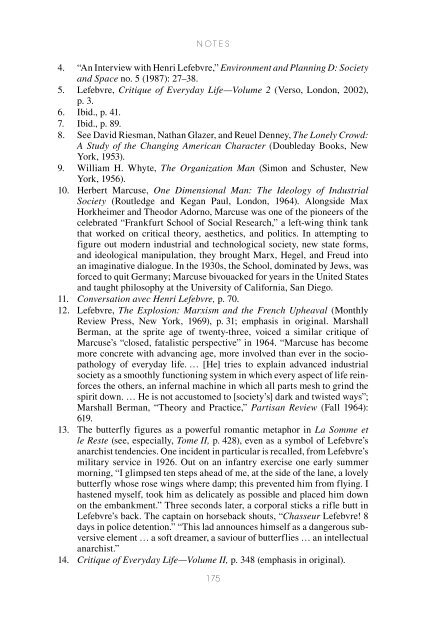Henri Lefebvre: A Critical Introduction - autonomous learning
Henri Lefebvre: A Critical Introduction - autonomous learning
Henri Lefebvre: A Critical Introduction - autonomous learning
Create successful ePaper yourself
Turn your PDF publications into a flip-book with our unique Google optimized e-Paper software.
n o t e s<br />
4. “An Interview with <strong>Henri</strong> <strong>Lefebvre</strong>,” Environment and Planning D: Society<br />
and Space no. 5 (1987): 27–38.<br />
5. <strong>Lefebvre</strong>, Critique of Everyday Life—Volume 2 (Verso, London, 2002),<br />
p. 3.<br />
6. Ibid., p. 41.<br />
7. Ibid., p. 89.<br />
8. See David Riesman, Nathan Glazer, and Reuel Denney, The Lonely Crowd:<br />
A Study of the Changing American Character (Doubleday Books, New<br />
York, 1953).<br />
9. William H. Whyte, The Organization Man (Simon and Schuster, New<br />
York, 1956).<br />
10. Herbert Marcuse, One Dimensional Man: The Ideology of Industrial<br />
Society (Routledge and Kegan Paul, London, 1964). Alongside Max<br />
Horkheimer and Theodor Adorno, Marcuse was one of the pioneers of the<br />
celebrated “Frankfurt School of Social Research,” a left-wing think tank<br />
that worked on critical theory, aesthetics, and politics. In attempting to<br />
figure out modern industrial and technological society, new state forms,<br />
and ideological manipulation, they brought Marx, Hegel, and Freud into<br />
an imaginative dialogue. In the 1930s, the School, dominated by Jews, was<br />
forced to quit Germany; Marcuse bivouacked for years in the United States<br />
and taught philosophy at the University of California, San Diego.<br />
11. Conversation avec <strong>Henri</strong> <strong>Lefebvre</strong>, p. 70.<br />
12. <strong>Lefebvre</strong>, The Explosion: Marxism and the French Upheaval (Monthly<br />
Review Press, New York, 1969), p. 31; emphasis in original. Marshall<br />
Berman, at the sprite age of twenty-three, voiced a similar critique of<br />
Marcuse’s “closed, fatalistic perspective” in 1964. “Marcuse has become<br />
more concrete with advancing age, more involved than ever in the sociopathology<br />
of everyday life. … [He] tries to explain advanced industrial<br />
society as a smoothly functioning system in which every aspect of life reinforces<br />
the others, an infernal machine in which all parts mesh to grind the<br />
spirit down. … He is not accustomed to [society’s] dark and twisted ways”;<br />
Marshall Berman, “Theory and Practice,” Partisan Review (Fall 1964):<br />
619.<br />
13. The butterfly figures as a powerful romantic metaphor in La Somme et<br />
le Reste (see, especially, Tome II, p. 428), even as a symbol of <strong>Lefebvre</strong>’s<br />
anarchist tendencies. One incident in particular is recalled, from <strong>Lefebvre</strong>’s<br />
military service in 1926. Out on an infantry exercise one early summer<br />
morning, “I glimpsed ten steps ahead of me, at the side of the lane, a lovely<br />
butterfly whose rose wings where damp; this prevented him from flying. I<br />
hastened myself, took him as delicately as possible and placed him down<br />
on the embankment.” Three seconds later, a corporal sticks a rifle butt in<br />
<strong>Lefebvre</strong>’s back. The captain on horseback shouts, “Chasseur <strong>Lefebvre</strong>! 8<br />
days in police detention.” “This lad announces himself as a dangerous subversive<br />
element … a soft dreamer, a saviour of butterflies … an intellectual<br />
anarchist.”<br />
14. Critique of Everyday Life—Volume II, p. 348 (emphasis in original).<br />
175
















